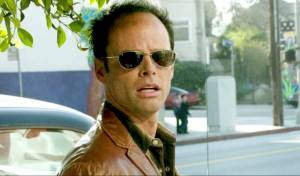
IDW Publishing has been drafting the iconic British comics character Judge Dredd into the American comics scene with an outstanding set of new series and miniseries over the past several years from top writing and artistic talent. With the satirical take on social stratification and demagoguery in “Under Siege” all wrapped up, a new miniseries, “Toxic!,” takes its place this week. Judge Dredd: Toxic! is British writer Paul Jenkins’ (Hellblazer, Spectacular Spider-Man) first time writing Dredd, and he’s joined by artist Marco Castiello (Batman Beyond) for what is sure to be an exciting and darkly funny take on xenophobia in Mega-City One.
Videos by ComicBook.com
While most American readers aren’t likely to be familiar with the history of Judge Dredd, his current incarnations in both the British and American comics scenes is preceded by more than 40 years of history. The character was conceived of alongside the creation of the anthology publication 2000 A.D., with both making their debuts in 1977. Dredd has been a staple of that particular comic and international fandom ever since, with his helmet often featured in any collection of the most recognizable characters from across the medium. It’s easy for American readers to point out recent stories that struck a nerve, both “Mega-City Two” and “Mega-City Zero” being outstanding examples, but they don’t clarify the longevity of this violent agent of the law. So what is it about Judge Dredd that has allowed him to not only stand the test of time but also thrive across four decades of comics?

The Original Design
Like so many familiar superheroes from American comics, the defining elements of greatness were apparent from the very first appearance of Judge Dredd. The story of how his initial appearance and stories were crafted shows just how important collaboration in comics can be, though. Dredd is the brainchild of three creators and integral influences on the earliest days of 2000 A.D.: artist Carlos Ezquerra and writers Pat Mills and John Wagner. Wagner was brought in by his sometimes-writing partner Mills to develop a strip that would take the violent police officer archetype to its most extreme conclusion. They advanced the concept together with Wagner taking the name Dredd from a discarded horror pitch created by Mills. Once they had a concept prepared for Judge Dredd, Ezquerra was brought in to design the character and draw the first story. He provided the memorably large helmet, oversized eagle on the shoulder, and plenty of chains and zippers on the costume. Ezquerra designed Mega-City One to be far different from any modern metropolis, pushing the story much further into the future.
These artistic changes, along with a rejection of his story due to violence, were a source of tension for Wagner, resulting in him leaving the project. However, they were essential to defining Judge Dredd as a lasting comics character.
The visual design of Dredd has been modified over the years for special purposes, but the ongoing stories in 2000 A.D. and most adaptations in comics and film feature a suit much like the one first drawn by Ezquerra. It is reliably impactful in a way that many classic looks, even those of Superman or Captain America, have not been across so many years. That memorable look is enhanced by a perfectly ludicrous setting. The original dystopian future was meant to be close to the present, much like the decaying Britain pictured in V for Vendetta only five years later. Stretching the story into the far future allowed for the stories to adapt more extreme ideas and provide more humor within the grim setting. The mega-blocks, mutants, and long history of nuclear war and government reorganization provided a fertile starting point for decades of stories. Despite some creative differences, the Judge Dredd that first appeared in 2000 A.D. #2 was already an icon capable of shaping comics history.

Still Life Evolution
Dredd’s design and setting are not the only two elements to remain largely unchanged across so many years of stories. Joe Dredd, the man beneath the helmet, has been one of the few constants in the world he occupies. Even as massive wars rage, entire populations are destroyed, and the institutions he occupies are upended, Dredd’s character has stood with the same resolve that he first entered 2000 A.D. with. As a figure based upon the likes of Clint Eastwood’s Dirty Harry, his disgust for crime in any form and unwillingness to compromise have withstood an endless onslaught of tests, leaving readers with a character in 2018 who is very familiar to the one they first met in 1977.
This is a feature, not a bug in the character. While many narratives focus on a character being changed by the world, Dredd is a character who changes the world. He provides a lens into fascism post-World War II, the violence of the state, and the nature of justice, all themes that require different stories over time. Both Dredd’s city and his supporting cast have evolved to tell new tales reflecting these core concepts, while Dredd stands steady as an unstoppable force committed to his ideals, regardless of whether they are shared with readers.

Captured Imaginations
It’s the enduring importance of these themes that have kept Judge Dredd relevant for so long as well. A version of Joe Dredd that learns to soften his perspective and become much more lenient might be more likable, but would not offer an appetizing vision of the terrifying future he occupies. Dredd speaks to some of the darkest and most violent impulses in modern society, and as a result has continued to capture the imaginations of outstanding creators both in comics and in outside media.
Judge Dredd’s original creators, Wagner, Mills, and Ezquerra, are already an outstanding list of talent, and with each passing year 2000 A.D. has added more impressive names to the laundry list of insightful voices seeking to tell Dredd’s story. Brian Bolland, Alan Grant, Mike McMahon, Steve Dillon, Ulises Farinas… and the list goes on and on. Dredd evokes new stories with new takes from each generation of comics creators, and has made leaps to film, television, video games, and more. The most recent movie adaptation, 2012’s Dredd, quickly became a cult hit valued for its representation of the character, propulsive action, and entertaining social commentary. While this movie has failed to garner a sequel in the face of multiple campaigns, it’s clear that this won’t be the last adaptation of Judge Dredd to the big or small screen. Even after 40 years of comics, great stories are still emerging with no sign of that changing without the Atomic Wars bringing our own timeline into continuity with his own.









